Spatial and Temporal Patterns of Mangrove Forest Change in the Mekong Region over Four Decades Based on a Remote Sensing Data-Driven Approach
Highlights
- Random Forest classification achieved a mapping accuracy of 86.2% to 88.8%.
- Mangrove extent was mapped from 1984 to 2023 in the Mekong region.
- Thailand’s mangrove area increased by 12.9% and Vietnam’s by 28.4% since 1984.
- Mangrove areas in Cambodia and Myanmar declined by about 14.6% and 22.7%, respectively.
Abstract
1. Introduction
2. Materials and Methods
2.1. Study Area and Data Collection
2.1.1. Study Areas
2.1.2. Reference Dataset
2.1.3. Remote Sensing Data Acquisition
2.1.4. Auxiliary Datasets
2.2. The Mangrove Classification
- Step 1: Image pre-processing
- Step 2: Spectral extraction and potential mangrove area
- Step 3: Modeling
2.3. Accuracy Assessment
3. Results
3.1. Optimal Feature Selection
3.2. Validated Mangrove Mapping
3.3. Mangrove Mapping and Mangrove Area Assessment
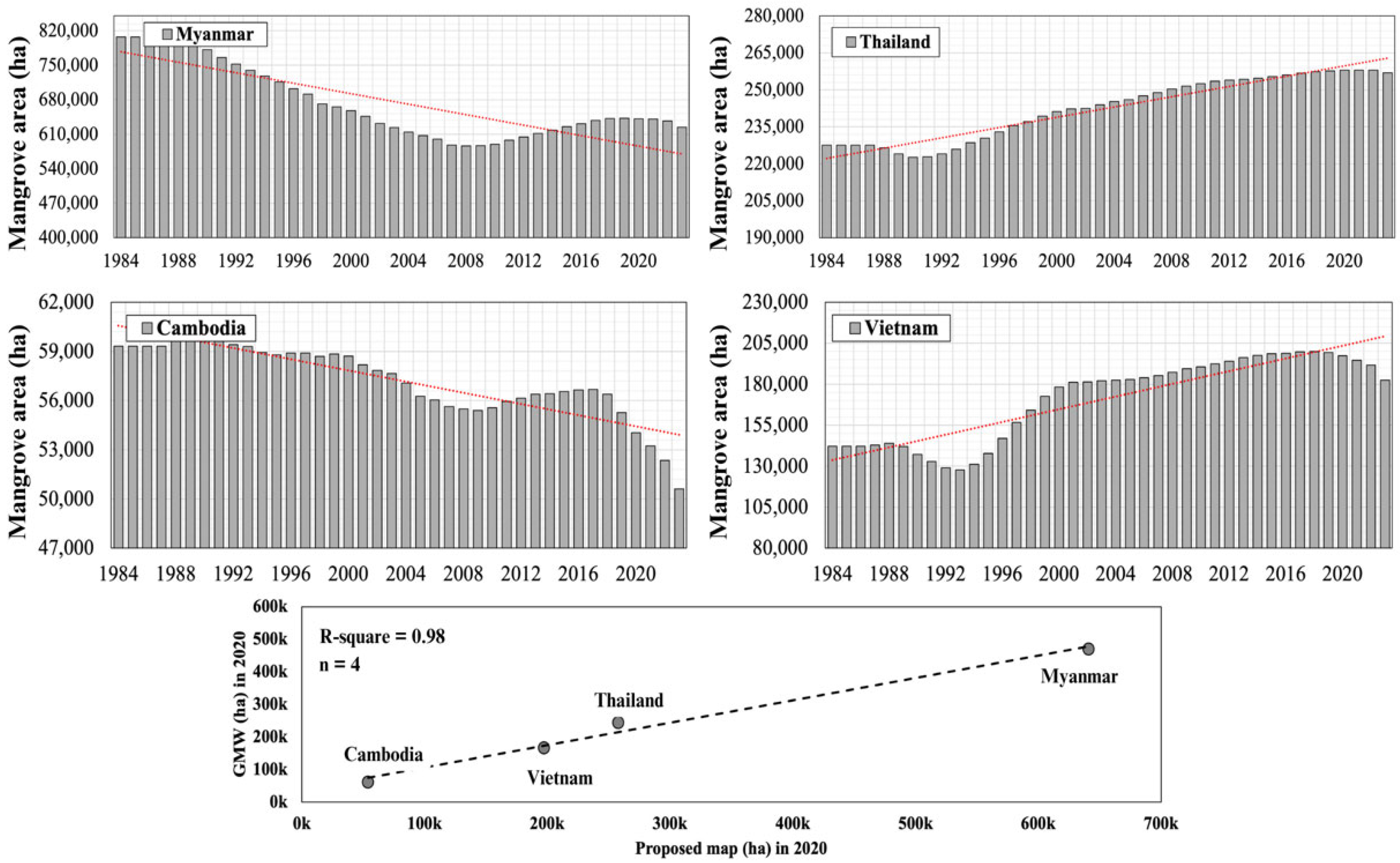
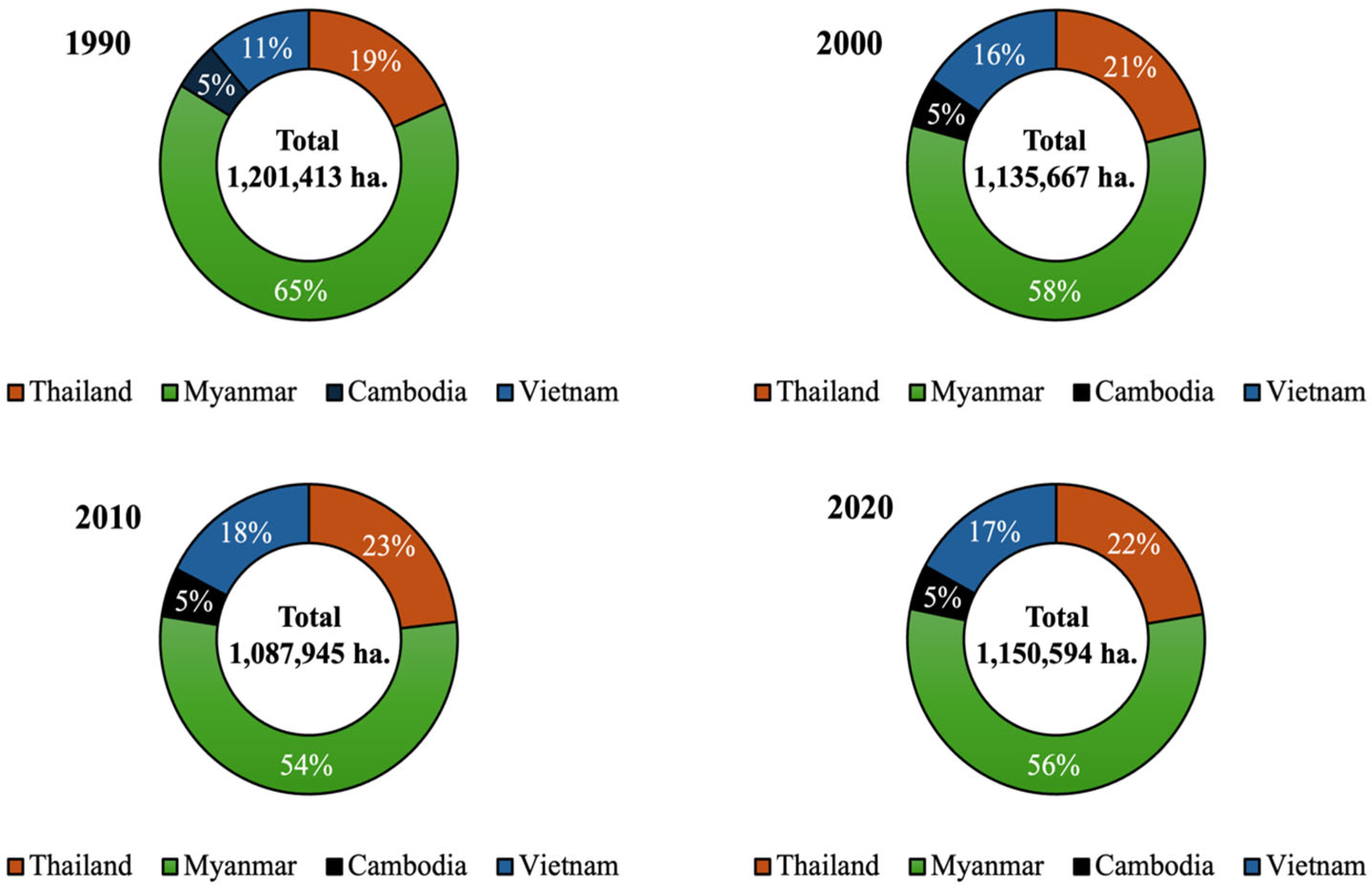
4. Discussion
4.1. Spectral Reflectance of Mangrove Forest in Each Country and Feature Selection
4.2. Predictive Model Performances
4.3. Comparison of Mangrove Mapping with Existing Studies
4.4. Limitations and Outlook
5. Conclusions
Author Contributions
Funding
Data Availability Statement
Acknowledgments
Conflicts of Interest
References
- Sharma, S.; MacKenzie, R.A.; Tieng, T.; Soben, K.; Tulyasuwan, N.; Resanond, A.; Blate, G.; Litton, C.M. The Impacts of Degradation, Deforestation and Restoration on Mangrove Ecosystem Carbon Stocks across Cambodia. Sci. Total Environ. 2020, 706, 135416. [Google Scholar] [CrossRef] [PubMed]
- Lu, Y.; Wang, L. How to Automate Timely Large-Scale Mangrove Mapping with Remote Sensing. Remote Sens. Environ. 2021, 264, 112584. [Google Scholar] [CrossRef]
- Rahman; Ceanturi, A.; Tuahatu, J.W.; Lokollo, F.F.; Supusepa, J.; Hulopi, M.; Permatahati, Y.I.; Lewerissa, Y.A.; Wardiatno, Y. Mangrove Ecosystems in Southeast Asia Region: Mangrove Extent, Blue Carbon Potential and CO2 Emissions in 1996–2020. Sci. Total Environ. 2024, 915, 170052. [Google Scholar] [CrossRef] [PubMed]
- Hamdan, O.; Khali Aziz, H.; Mohd Hasmadi, I. L-Band ALOS PALSAR for Biomass Estimation of Matang Mangroves, Malaysia. Remote Sens. Environ. 2014, 155, 69–78. [Google Scholar] [CrossRef]
- Polidoro, B.A.; Carpenter, K.E.; Collins, L.; Duke, N.C.; Ellison, A.M.; Ellison, J.C.; Farnsworth, E.J.; Fernando, E.S.; Kathiresan, K.; Koedam, N.E.; et al. The Loss of Species: Mangrove Extinction Risk and Geographic Areas of Global Concern. PLoS ONE 2010, 5, e10095. [Google Scholar] [CrossRef]
- Baltezar, P.; Murillo-Sandoval, P.J.; Cavanaugh, K.C.; Doughty, C.; Lagomasino, D.; Tieng, T.; Simard, M.; Fatoyinbo, T. A Regional Map of Mangrove Extent for Myanmar, Thailand, and Cambodia Shows Losses of 44% by 1996. Front. Mar. Sci. 2023, 10, 1127720. [Google Scholar] [CrossRef]
- Tinh, P.H.; MacKenzie, R.A.; Hung, T.D.; Hanh, N.T.H.; Hanh, N.H.; Manh, D.Q.; Ha, H.T.; Tuan, M.S. Distribution and Drivers of Vietnam Mangrove Deforestation from 1995 to 2019. Mitig. Adapt. Strat. Glob. Chang. 2022, 27, 29. [Google Scholar] [CrossRef]
- Spalding, M.; Kainuma, M.; Collins, L. Book Review: World Atlas of Mangroves; Wetlands; Routledge: London, UK, 2010; Volume 31. [Google Scholar]
- FAO; UNDP; UNEP. Land Degradation in South Asia: Its Severity, Causes and Effects upon the People; FAO: Rome, Italy, 1994; Volume 78. [Google Scholar]
- Richards, D.R.; Friess, D.A. Rates and Drivers of Mangrove Deforestation in Southeast Asia, 2000–2012. Proc. Natl. Acad. Sci. USA 2016, 113, 344–349. [Google Scholar] [CrossRef]
- Giri, C.; Zhu, Z.; Tieszen, L.L.; Singh, A.; Gillette, S.; Kelmelis, J.A. Mangrove Forest Distributions and Dynamics (1975–2005) of the Tsunami-affected Region of Asia. J. Biogeogr. 2008, 35, 519–528. [Google Scholar] [CrossRef]
- Thampanya, U.; Vermaat, J.E.; Sinsakul, S.; Panapitukkul, N. Coastal Erosion and Mangrove Progradation of Southern Thailand. Estuar. Coast. Shelf Sci. 2006, 68, 75–85. [Google Scholar] [CrossRef]
- Pimple, U.; Simonetti, D.; Peters, R.; Berger, U.; Podest, E.; Gond, V. Enhancing Monitoring of Mangrove Spatiotemporal Tree Diversity and Distribution Patterns. Land. Degrad. Dev. 2023, 34, 1265–1282. [Google Scholar] [CrossRef]
- Alexopoulos, A.; Koutras, K.; Ben Ali, S.; Puccio, S.; Carella, A.; Ottaviano, R.; Kalogeras, A. Complementary Use of Ground-Based Proximal Sensing and Airborne/Spaceborne Remote Sensing Techniques in Precision Agriculture: A Systematic Review. Agronomy 2023, 13, 1942. [Google Scholar] [CrossRef]
- Chaiyana, A.; Khiripet, N.; Ninsawat, S.; Siriwan, W.; Shanmugam, M.S.; Virdis, S.G.P. Early Prediction of Cassava Mosaic Disease Onset Based on Remote Sensing and Climatic Data. Comput. Electron. Agric. 2025, 230, 109836. [Google Scholar] [CrossRef]
- Chaiyana, A.; Kumari, A.; Jagadish, S.V.K. Crop Field Segmentation and Irrigation Water Source Attribution for Groundwater Monitoring and Projection toward Conservation in the Texas High Plains. Sci. Total Environ. 2025, 994, 180031. [Google Scholar] [CrossRef] [PubMed]
- Cui, B.; Fei, D.; Shao, G.; Lu, Y.; Chu, J. Extracting Raft Aquaculture Areas from Remote Sensing Images via an Improved U-Net with a PSE Structure. Remote Sens. 2019, 11, 2053. [Google Scholar] [CrossRef]
- Chatziantoniou, A.; Charalampis Spondylidis, S.; Stavrakidis-Zachou, O.; Papandroulakis, N.; Topouzelis, K. Dissolved Oxygen Estimation in Aquaculture Sites Using Remote Sensing and Machine Learning. Remote Sens. Appl. 2022, 28, 100865. [Google Scholar] [CrossRef]
- Dadkhah, H.; Rana, D.; Ghaderpour, E.; Mazzanti, P. Analyzing Wildfire Patterns and Climate Interactions in Campania, Italy: A Multi-Sensor Remote Sensing Study. Ecol. Inf. 2025, 90, 103249. [Google Scholar] [CrossRef]
- Yang, H.; Kong, J.; Hu, H.; Du, Y.; Gao, M.; Chen, F. A Review of Remote Sensing for Water Quality Retrieval: Progress and Challenges. Remote Sens. 2022, 14, 1770. [Google Scholar] [CrossRef]
- Sun, Y.; Wang, D.; Li, L.; Ning, R.; Yu, S.; Gao, N. Application of Remote Sensing Technology in Water Quality Monitoring: From Traditional Approaches to Artificial Intelligence. Water Res. 2024, 267, 122546. [Google Scholar] [CrossRef]
- Hussain, S.; Lu, L.; Mubeen, M.; Nasim, W.; Karuppannan, S.; Fahad, S.; Tariq, A.; Mousa, B.G.; Mumtaz, F.; Aslam, M. Spatiotemporal Variation in Land Use Land Cover in the Response to Local Climate Change Using Multispectral Remote Sensing Data. Land 2022, 11, 595. [Google Scholar] [CrossRef]
- Zhang, R.; Jia, M.; Wang, Z.; Zhou, Y.; Mao, D.; Ren, C.; Zhao, C.; Liu, X. Tracking Annual Dynamics of Mangrove Forests in Mangrove National Nature Reserves of China Based on Time Series Sentinel-2 Imagery during 2016–2020. Int. J. Appl. Earth Obs. Geoinf. 2022, 112, 102918. [Google Scholar] [CrossRef]
- Chan-Bagot, K.; Herndon, K.E.; Puzzi Nicolau, A.; Martín-Arias, V.; Evans, C.; Parache, H.; Mosely, K.; Narine, Z.; Zutta, B. Integrating SAR, Optical, and Machine Learning for Enhanced Coastal Mangrove Monitoring in Guyana. Remote Sens. 2024, 16, 542. [Google Scholar] [CrossRef]
- Pirasteh, S.; Mafi-Gholami, D.; Li, H.; Fang, Z.; Nouri-Kamari, A.; Khorrami, B. Precision in Mapping and Assessing Mangrove Biomass: Insights from the Persian Gulf Coasts. Int. J. Appl. Earth Obs. Geoinf. 2024, 128, 103769. [Google Scholar] [CrossRef]
- Sun, Z.; Jiang, W.; Ling, Z.; Zhong, S.; Zhang, Z.; Song, J.; Xiao, Z. Using Multisource High-Resolution Remote Sensing Data (2 m) with a Habitat–Tide–Semantic Segmentation Approach for Mangrove Mapping. Remote Sens. 2023, 15, 5271. [Google Scholar] [CrossRef]
- Du, S.; Du, S.; Liu, B.; Zhang, X. Mapping Large-Scale and Fine-Grained Urban Functional Zones from VHR Images Using a Multi-Scale Semantic Segmentation Network and Object Based Approach. Remote Sens. Environ. 2021, 261, 112480. [Google Scholar] [CrossRef]
- Aviña-Hernández, J.; Ramírez-Vargas, M.; Roque-Sosa, F.; Martínez-Rincón, R.O. Predictive Performance of Random Forest on the Identification of Mangrove Species in Arid Environments. Ecol. Inf. 2023, 75, 102040. [Google Scholar] [CrossRef]
- Aji, M.A.P.; Kamal, M.; Farda, N.M. Mangrove Species Mapping through Phenological Analysis Using Random Forest Algorithm on Google Earth Engine. Remote Sens. Appl. 2023, 30, 100978. [Google Scholar] [CrossRef]
- Zhao, C.; Jia, M.; Wang, Z.; Mao, D.; Wang, Y. Identifying Mangroves through Knowledge Extracted from Trained Random Forest Models: An Interpretable Mangrove Mapping Approach (IMMA). ISPRS J. Photogramm. Remote Sens. 2023, 201, 209–225. [Google Scholar] [CrossRef]
- Miraki, M.; Sohrabi, H.; Immitzer, M. Tree Species Mapping in Mangrove Ecosystems Using UAV-RGB Imagery and Object-Based Image Classification. J. Indian. Soc. Remote Sens. 2023, 51, 2095–2103. [Google Scholar] [CrossRef]
- Kennedy, R.E.; Yang, Z.; Gorelick, N.; Braaten, J.; Cavalcante, L.; Cohen, W.B.; Healey, S. Implementation of the LandTrendr Algorithm on Google Earth Engine. Remote Sens. 2018, 10, 691. [Google Scholar] [CrossRef]
- Shimizu, K.; Murakami, W.; Furuichi, T.; Estoque, R.C. Mapping Land Use/Land Cover Changes and Forest Disturbances in Vietnam Using a Landsat Temporal Segmentation Algorithm. Remote Sens. 2023, 15, 851. [Google Scholar] [CrossRef]
- Parracciani, C.; Gigante, D.; Mutanga, O.; Bonafoni, S.; Vizzari, M. Land Cover Changes in Grassland Landscapes: Combining Enhanced Landsat Data Composition, LandTrendr, and Machine Learning Classification in Google Earth Engine with MLP-ANN Scenario Forecasting. GIsci Remote Sens. 2024, 61, 2302221. [Google Scholar] [CrossRef]
- Yin, X.; Chen, B.; Gu, X.; Yun, T.; Wu, Z.; Chen, Y.; Lai, H.; Kou, W. Rapid Monitoring of Tropical Forest Disturbance in Hainan Island Based on GEE Platform and LandTrendr Algorithm. J. Geo-Inf. Sci. 2023, 25, 220691. [Google Scholar] [CrossRef]
- Zhang, X.K.; Zhang, X.; Lan, Q.Q.; Ali Baig, M.H. Automated Detection of Coastline Using Landsat TM Based on Water Index and Edge Detection Methods. In Proceedings of the 2nd International Workshop on Earth Observation and Remote Sensing Applications, EORSA 2012, Shanghai, China, 8–11 June 2012. [Google Scholar]
- Saah, D.; Johnson, G.; Ashmall, B.; Tondapu, G.; Tenneson, K.; Patterson, M.; Poortinga, A.; Markert, K.; Quyen, N.H.; San Aung, K.; et al. Collect Earth: An Online Tool for Systematic Reference Data Collection in Land Cover and Use Applications. Environ. Model. Softw. 2019, 118, 166–171. [Google Scholar] [CrossRef]
- Huete, A.; Didan, K.; Miura, T.; Rodriguez, E.P.; Gao, X.; Ferreira, L.G. Overview of the Radiometric and Biophysical Performance of the MODIS Vegetation Indices. Remote Sens. Environ. 2002, 83, 195–213. [Google Scholar] [CrossRef]
- Rouse, J.W.; Haas, R.H.; Schell, J.A.; Deering, D.W. Monitoring Vegetation Systems in the Great Plains with ERTS; NASA Special Publication; NASA: Washington, DC, USA, 1974; Volume 24. [Google Scholar]
- Gitelson, A.A.; Kaufman, Y.J.; Merzlyak, M.N. Use of a Green Channel in Remote Sensing of Global Vegetation from EOS- MODIS. Remote Sens. Environ. 1996, 58, 289–298. [Google Scholar] [CrossRef]
- Huete, A. A Soil-Adjusted Vegetation Index (SAVI). Remote Sens. Environ. 1988, 25, 295–309. [Google Scholar] [CrossRef]
- Roujean, J.L.; Breon, F.M. Estimating PAR Absorbed by Vegetation from Bidirectional Reflectance Measurements. Remote Sens. Environ. 1995, 51, 375–384. [Google Scholar] [CrossRef]
- Baloloy, A.B.; Blanco, A.C.; Raymund Rhommel, R.R.C.; Nadaoka, K. Development and Application of a New Mangrove Vegetation Index (MVI) for Rapid and Accurate Mangrove Mapping. ISPRS J. Photogramm. Remote Sens. 2020, 166, 95–117. [Google Scholar] [CrossRef]
- Gao, B.C. NDWI—A Normalized Difference Water Index for Remote Sensing of Vegetation Liquid Water from Space. Remote Sens. Environ. 1996, 58, 257–266. [Google Scholar] [CrossRef]
- Gupta, K.; Mukhopadhyay, A.; Giri, S.; Chanda, A.; Datta Majumdar, S.; Samanta, S.; Mitra, D.; Samal, R.N.; Pattnaik, A.K.; Hazra, S. An Index for Discrimination of Mangroves from Non-Mangroves Using LANDSAT 8 OLI Imagery. MethodsX 2018, 5, 1129–1139. [Google Scholar] [CrossRef]
- Chandrasekar, K.; Sesha Sai, M.V.R.; Roy, P.S.; Dwevedi, R.S. Land Surface Water Index (LSWI) Response to Rainfall and NDVI Using the MODIS Vegetation Index Product. Int. J. Remote Sens. 2010, 31, 3987–4005. [Google Scholar] [CrossRef]
- Bunting, P.; Rosenqvist, A.; Hilarides, L.; Lucas, R.M.; Thomas, N.; Tadono, T.; Worthington, T.A.; Spalding, M.; Murray, N.J.; Rebelo, L.M. Global Mangrove Extent Change 1996–2020: Global Mangrove Watch Version 3.0. Remote Sens. 2022, 14, 3657. [Google Scholar] [CrossRef]
- Jia, M.; Wang, Z.; Mao, D.; Ren, C.; Song, K.; Zhao, C.; Wang, C.; Xiao, X.; Wang, Y. Mapping Global Distribution of Mangrove Forests at 10-m Resolution. Sci. Bull. 2023, 68, 1306–1316. [Google Scholar] [CrossRef]
- Tadono, T.; Ishida, H.; Oda, F.; Naito, S.; Minakawa, K.; Iwamoto, H. Precise Global DEM Generation by ALOS PRISM. ISPRS Ann. Photogramm. Remote Sens. Spat. Inf. Sci. 2014, II–4, 71–76. [Google Scholar] [CrossRef]
- Pekel, J.F.; Cottam, A.; Gorelick, N.; Belward, A.S. High-Resolution Mapping of Global Surface Water and Its Long-Term Changes. Nature 2016, 540, 418–422. [Google Scholar] [CrossRef] [PubMed]
- Triwijoyo, B.K.; Adil, A. Analysis of Medical Image Resizing Using Bicubic Interpolation Algorithm. J. Ilmu Komput. 2021, 14, 20–29. [Google Scholar] [CrossRef]
- Goh, T.Y.; Basah, S.N.; Yazid, H.; Aziz Safar, M.J.; Ahmad Saad, F.S. Performance Analysis of Image Thresholding: Otsu Technique. Measurement 2018, 114, 298–307. [Google Scholar] [CrossRef]
- Sekehravani, E.A.; Babulak, E.; Masoodi, M. Implementing Canny Edge Detection Algorithm for Noisy Image. Bull. Electr. Eng. Inform. 2020, 9, 1837. [Google Scholar] [CrossRef]
- Colditz, R.R.; Acosta-Velázquez, J.; Díaz Gallegos, J.R.; De Vázquez Lule, A.; Rodríguez-Zúñiga, M.T.; Maeda, P.; Cruz López, M.I.; Ressl, R. Potential Effects in Multi-Resolution Post-Classification Change Detection. Int. J. Remote Sens. 2012, 33, 6426–6445. [Google Scholar] [CrossRef]
- Bunting, P.; Rosenqvist, A.; Lucas, R.M.; Rebelo, L.M.; Hilarides, L.; Thomas, N.; Hardy, A.; Itoh, T.; Shimada, M.; Finlayson, C.M. The Global Mangrove Watch—A New 2010 Global Baseline of Mangrove Extent. Remote Sens 2018, 10, 1669. [Google Scholar] [CrossRef]
- Wallis, S. Binomial Confidence Intervals and Contingency Tests: Mathematical Fundamentals and the Evaluation of Alternative Methods. J. Quant. Linguist. 2013, 20, 178–208. [Google Scholar] [CrossRef]
- Congalton, R.G. A Review of Assessing the Accuracy of Classifications of Remotely Sensed Data. Remote Sens. Environ. 1991, 37, 35–46. [Google Scholar] [CrossRef]
- Chicco, D.; Jurman, G. The Advantages of the Matthews Correlation Coefficient (MCC) over F1 Score and Accuracy in Binary Classification Evaluation. BMC Genom. 2020, 21, 6. [Google Scholar] [CrossRef]
- Lum, C.; Mackenzie, M.; Shaw-Feather, C.; Luker, E.; Dunbabin, M. Multispectral Imaging and Elevation Mapping from an Unmanned Aerial System for Precision Agriculture Applications. In Proceedings of the 13th International Conference on Precision Agriculture 2016, St. Louis, MO, USA, 31 July–3 August 2016. [Google Scholar]
- Huete, A.R. Remote Sensing for Environmental Monitoring. In Environmental Monitoring and Characterization; Elsevier: Amsterdam, The Netherlands, 2004; pp. 183–206. [Google Scholar]
- Zhang, H.; Li, J.; Liu, Q.; Lin, S.; Huete, A.; Liu, L.; Croft, H.; Clevers, J.G.P.W.; Zeng, Y.; Wang, X.; et al. A Novel Red-Edge Spectral Index for Retrieving the Leaf Chlorophyll Content. Methods Ecol. Evol. 2022, 13, 2771–2787. [Google Scholar] [CrossRef]
- Yang, G.; Huang, K.; Sun, W.; Meng, X.; Mao, D.; Ge, Y. Enhanced Mangrove Vegetation Index Based on Hyperspectral Images for Mapping Mangrove. ISPRS J. Photogramm. Remote Sens. 2022, 189, 236–254. [Google Scholar] [CrossRef]
- Ghulam, A.; Li, Z.L.; Qin, Q.M.; Tong, Q.X.; Wang, J.H.; Kasimu, A.; Zhu, L. A Method for Canopy Water Content Estimation for Highly Vegetated Surfaces-Shortwave Infrared Perpendicular Water Stress Index. Sci. China Ser. D Earth Sci. 2007, 50, 1359–1368. [Google Scholar] [CrossRef]
- Pasaribu, R.A.; Aditama, F.A.; Setyabudi, P. Object-Based Image Analysis (OBIA) for Mapping Mangrove Using Unmanned Aerial Vehicle (UAV) on Tidung Kecil Island, Kepulauan Seribu, DKI Jakarta Province. IOP Conf. Ser. Earth Environ. Sci. 2021, 944, 012037. [Google Scholar] [CrossRef]
- Lombard, F.; Andrieu, J. Mapping Mangrove Zonation Changes in Senegal with Landsat Imagery Using an Obia Approach Combined with Linear Spectral Unmixing. Remote Sens. 2021, 13, 1961. [Google Scholar] [CrossRef]
- Dang, K.B.; Nguyen, M.H.; Nguyen, D.A.; Phan, T.T.H.; Giang, T.L.; Pham, H.H.; Nguyen, T.N.; Van Tran, T.T.; Bui, D.T. Coastal Wetland Classification with Deep U-Net Convolutional Networks and Sentinel-2 Imagery: A Case Study at the Tien Yen Estuary of Vietnam. Remote Sens. 2020, 12, 3270. [Google Scholar] [CrossRef]
- Maung, W.S.; Tsuyuki, S.; Guo, Z. Improving Land Use and Land Cover Information of Wunbaik Mangrove Area in Myanmar Using U-Net Model with Multisource Remote Sensing Datasets. Remote Sens. 2023, 16, 76. [Google Scholar] [CrossRef]
- Fu, C.; Song, X.; Xie, Y.; Wang, C.; Luo, J.; Fang, Y.; Cao, B.; Qiu, Z. Research on the Spatiotemporal Evolution of Mangrove Forests in the Hainan Island from 1991 to 2021 Based on SVM and Res-UNet Algorithms. Remote Sens. 2022, 14, 5554. [Google Scholar] [CrossRef]
- Ghorbanian, A.; Zaghian, S.; Asiyabi, R.M.; Amani, M.; Mohammadzadeh, A.; Jamali, S. Mangrove Ecosystem Mapping Using Sentinel-1 and Sentinel-2 Satellite Images and Random Forest Algorithm in Google Earth Engine. Remote Sens. 2021, 13, 2665. [Google Scholar] [CrossRef]
- Goldberg, L.; Lagomasino, D.; Thomas, N.; Fatoyinbo, T. Global Declines in Human-Driven Mangrove Loss. Glob. Chang. Biol. 2020, 26, 5844–5855. [Google Scholar] [CrossRef]
- Purwanto, A.D.; Wikantika, K.; Deliar, A.; Darmawan, S. Decision Tree and Random Forest Classification Algorithms for Mangrove Forest Mapping in Sembilang National Park, Indonesia. Remote Sens. 2023, 15, 16. [Google Scholar] [CrossRef]
- Fu, B.; He, X.; Yao, H.; Liang, Y.; Deng, T.; He, H.; Fan, D.; Lan, G.; He, W. Comparison of RFE-DL and Stacking Ensemble Learning Algorithms for Classifying Mangrove Species on UAV Multispectral Images. Int. J. Appl. Earth Obs. Geoinf. 2022, 112, 102890. [Google Scholar] [CrossRef]
- Tsai, C.A.; Chang, Y.J. Efficient Selection of Gaussian Kernel SVM Parameters for Imbalanced Data. Genes 2023, 14, 583. [Google Scholar] [CrossRef]
- Yancho, J.M.M.; Jones, T.G.; Gandhi, S.R.; Ferster, C.; Lin, A.; Glass, L. The Google Earth Engine Mangrove Mapping Methodology (Geemmm). Remote Sens. 2020, 12, 3758. [Google Scholar] [CrossRef]
- Fauzi, A.I.; Immitzer, M.; Atzberger, C. Exploring New Mangrove Horizons: A Scalable Remote Sensing Approach with Planet-NICFI and Sentinel-2 Images. Ecol. Inf. 2025, 88, 103152. [Google Scholar] [CrossRef]
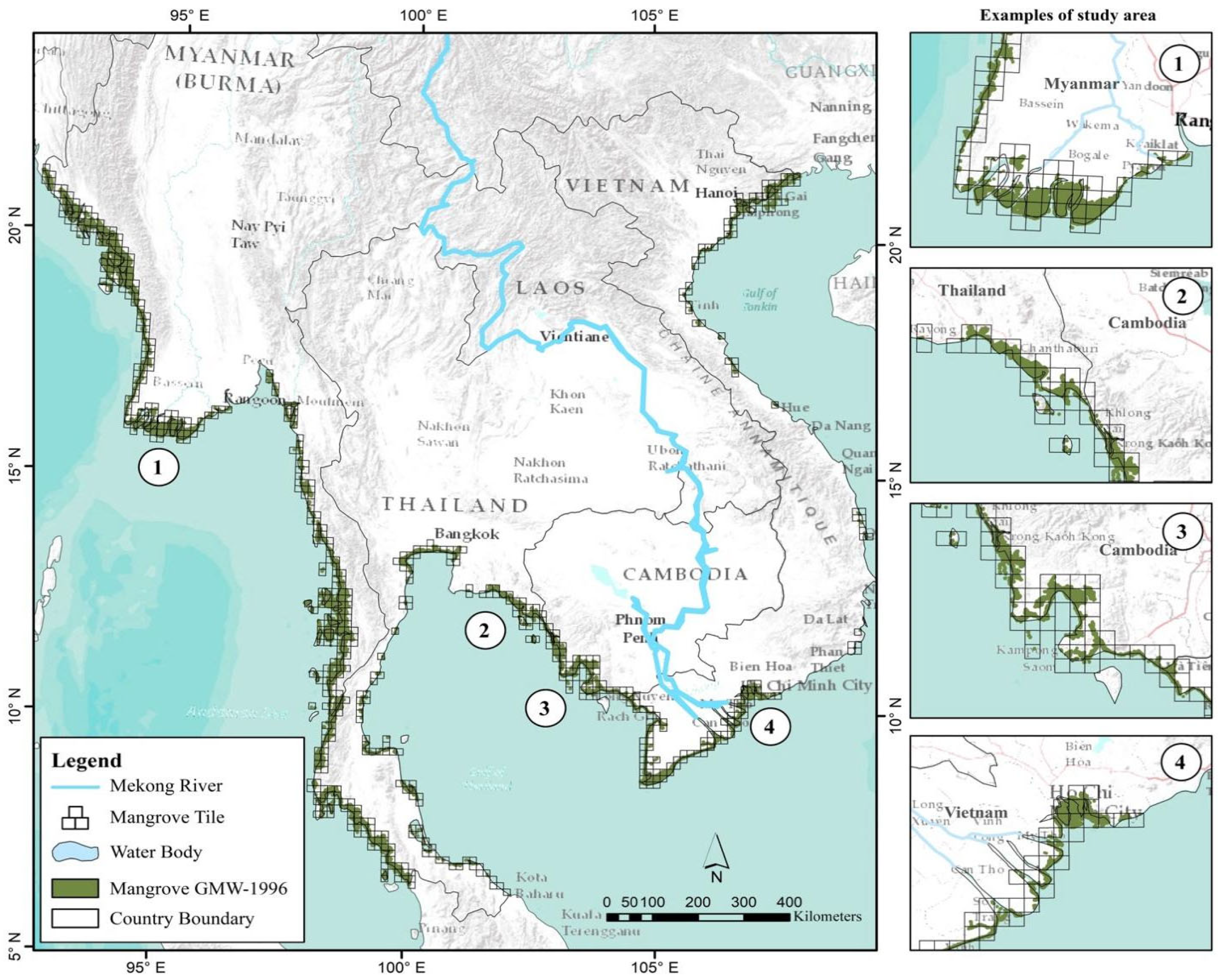


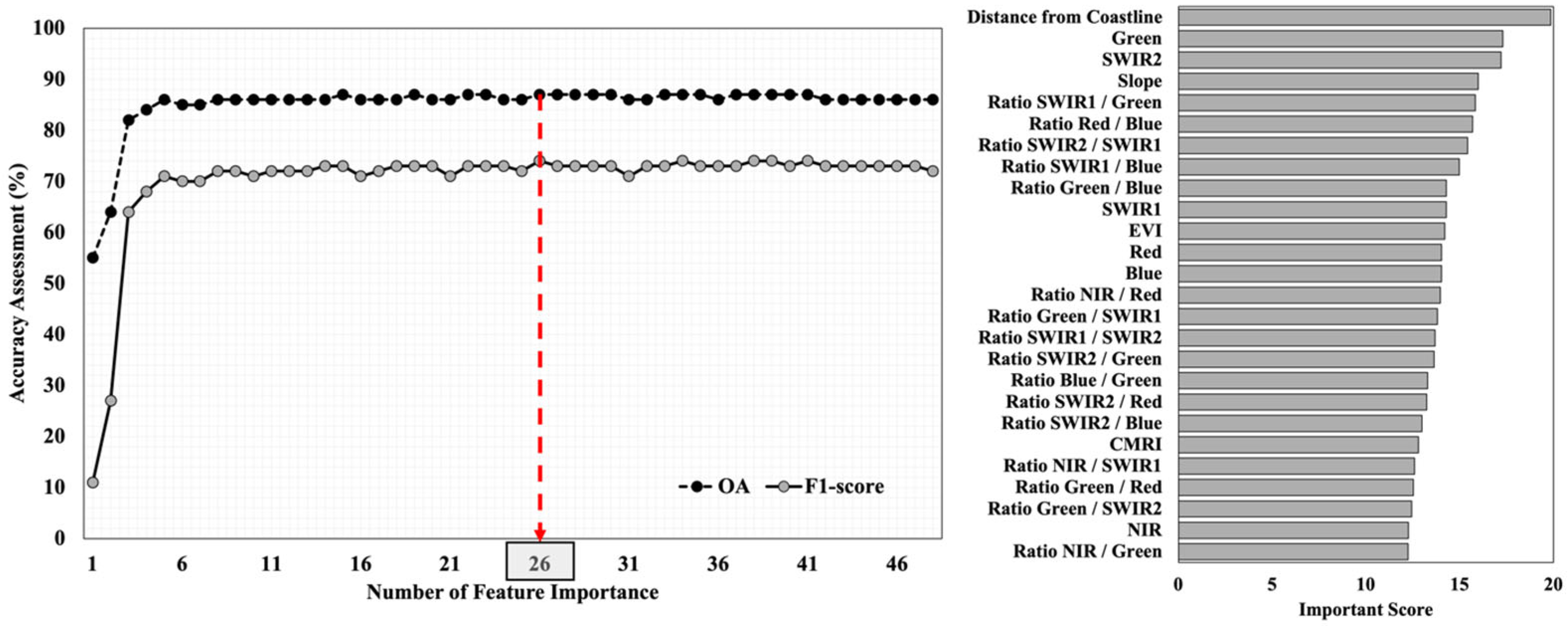
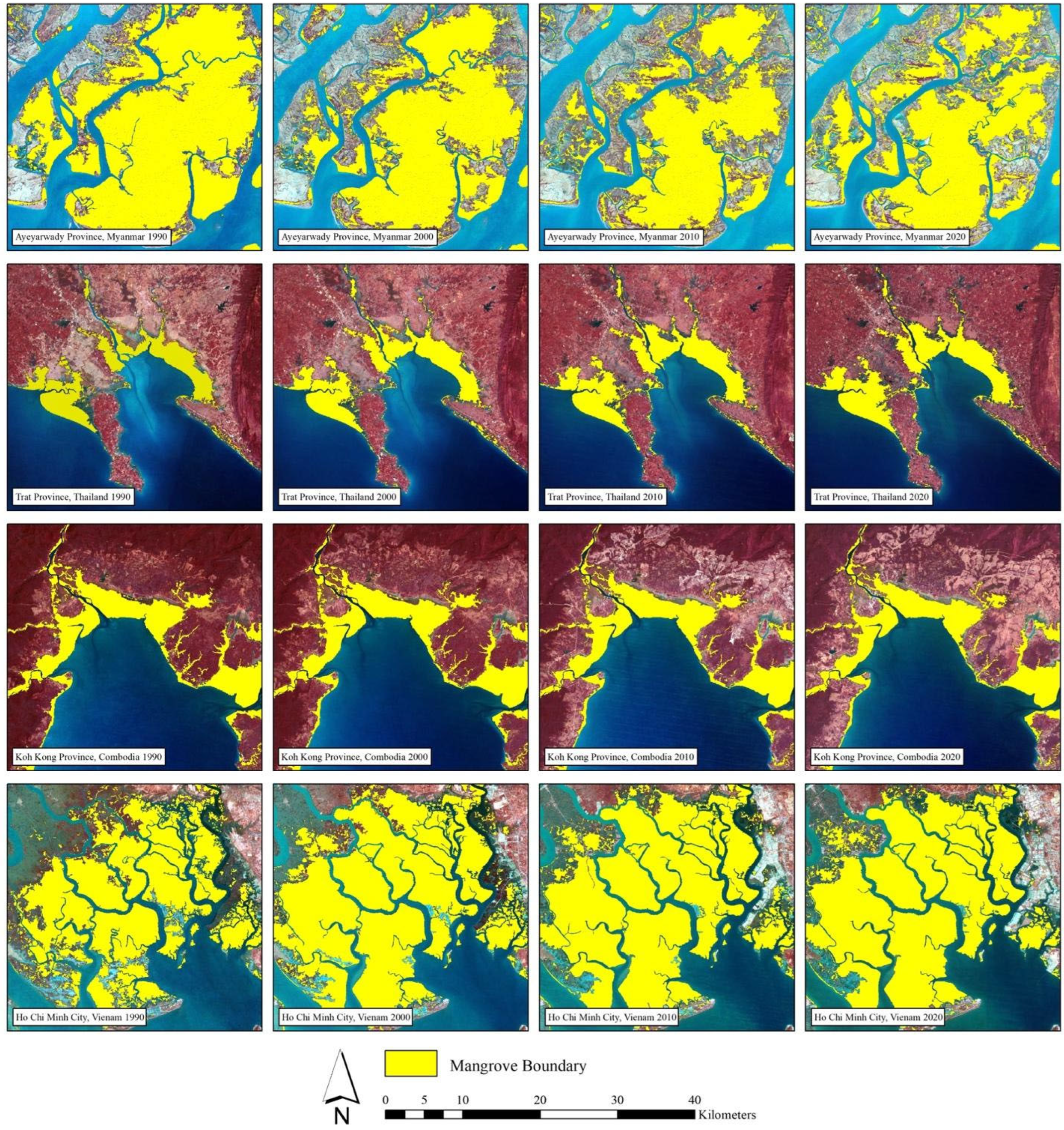


| Year | Mangrove | Non-Mangrove | |||||||
|---|---|---|---|---|---|---|---|---|---|
| Pond | Evergreen | Deciduous | Bare Land | Waterbody | Village | Building | Others | ||
| 2015 | 886 | 45 | 89 | 89 | 20 | 83 | 61 | 80 | 44 |
| 2016 | 1228 | 65 | 88 | 68 | 68 | 63 | 90 | 56 | 66 |
| 2017 | 490 | 76 | 70 | 67 | 67 | 71 | 74 | 70 | 64 |
| 2018 | 501 | 68 | 74 | 74 | 30 | 74 | 67 | 81 | 60 |
| 2019 | 344 | 60 | 35 | 68 | 72 | 64 | 60 | 82 | 75 |
| 2020 | 712 | 71 | 61 | 89 | 60 | 82 | 66 | 69 | 67 |
| 2021 | 401 | 64 | 81 | 81 | 64 | 45 | 79 | 86 | 67 |
| 2022 | 220 | 68 | 81 | 68 | 63 | 62 | 87 | 74 | 84 |
| 2023 | 218 | 80 | 50 | 78 | 84 | 84 | 66 | 74 | 87 |
| Total | 5000 | 597 | 629 | 682 | 528 | 628 | 650 | 672 | 614 |
| No. | Vegetation | Equation | Reference |
|---|---|---|---|
| 1 | Enhanced Vegetation Index (EVI) | [38] | |
| 2 | Normalized Difference Vegetation Index (NDVI) | [39] | |
| 3 | Green Normalized Difference Vegetation Index (GNDVI) | [40] | |
| 4 | Soil Adjusted Vegetation Index (SAVI) | [41] | |
| 5 | Re-Normalized Difference Vegetation Index (RDVI) | [42] | |
| 6 | Mangrove Vegetation Index (MVI) | [43] | |
| 7 | Normalized Difference Water Index (NDWI) | [44] | |
| 8 | Combined Mangrove Recognition Index (CMRI) | [45] | |
| 9 | Land Surface Water Index (LSWI) | [46] |
| No. | Definition | Equation | Reference |
|---|---|---|---|
| 1 | Overall Accuracy (OA) | [57] | |
| 2 | User’s Accuracy (UA) | ||
| 3 | Producer’s accuracy (PA) | ||
| 4 | OA of confidence Interval (CI) at 95% | [56] | |
| 5 | F1-score | [58] |
| Class | Mangrove | Non-Mangrove | Row Total | UA (%) | OA (%) | F1-Score (%) | CI95 (OA%) |
|---|---|---|---|---|---|---|---|
| Mangrove | 1305 | 195 | 1500 | 87.1 | 87.3 | 87.4 | 86.1–88.5 |
| Non-mangrove | 185 | 1315 | 1500 | 87.6 | |||
| Column Total | 1490 | 1510 | 2620 | - | |||
| PA (%) | 87.6 | 87.1 |
Disclaimer/Publisher’s Note: The statements, opinions and data contained in all publications are solely those of the individual author(s) and contributor(s) and not of MDPI and/or the editor(s). MDPI and/or the editor(s) disclaim responsibility for any injury to people or property resulting from any ideas, methods, instructions or products referred to in the content. |
© 2025 by the authors. Licensee MDPI, Basel, Switzerland. This article is an open access article distributed under the terms and conditions of the Creative Commons Attribution (CC BY) license (https://creativecommons.org/licenses/by/4.0/).
Share and Cite
Chaiyana, A.; Immitzer, M.; Som-ard, J.; Khamkhon, R.; Kangrang, A.; Kaewplang, S.; Laongmanee, W.; Koedsin, W.; Vaiphasa, C.; Huete, A. Spatial and Temporal Patterns of Mangrove Forest Change in the Mekong Region over Four Decades Based on a Remote Sensing Data-Driven Approach. Remote Sens. 2025, 17, 3728. https://doi.org/10.3390/rs17223728
Chaiyana A, Immitzer M, Som-ard J, Khamkhon R, Kangrang A, Kaewplang S, Laongmanee W, Koedsin W, Vaiphasa C, Huete A. Spatial and Temporal Patterns of Mangrove Forest Change in the Mekong Region over Four Decades Based on a Remote Sensing Data-Driven Approach. Remote Sensing. 2025; 17(22):3728. https://doi.org/10.3390/rs17223728
Chicago/Turabian StyleChaiyana, Akkarapon, Markus Immitzer, Jaturong Som-ard, Rangsan Khamkhon, Anongrit Kangrang, Siwa Kaewplang, Wirote Laongmanee, Werapong Koedsin, Chaichoke Vaiphasa, and Alfredo Huete. 2025. "Spatial and Temporal Patterns of Mangrove Forest Change in the Mekong Region over Four Decades Based on a Remote Sensing Data-Driven Approach" Remote Sensing 17, no. 22: 3728. https://doi.org/10.3390/rs17223728
APA StyleChaiyana, A., Immitzer, M., Som-ard, J., Khamkhon, R., Kangrang, A., Kaewplang, S., Laongmanee, W., Koedsin, W., Vaiphasa, C., & Huete, A. (2025). Spatial and Temporal Patterns of Mangrove Forest Change in the Mekong Region over Four Decades Based on a Remote Sensing Data-Driven Approach. Remote Sensing, 17(22), 3728. https://doi.org/10.3390/rs17223728












